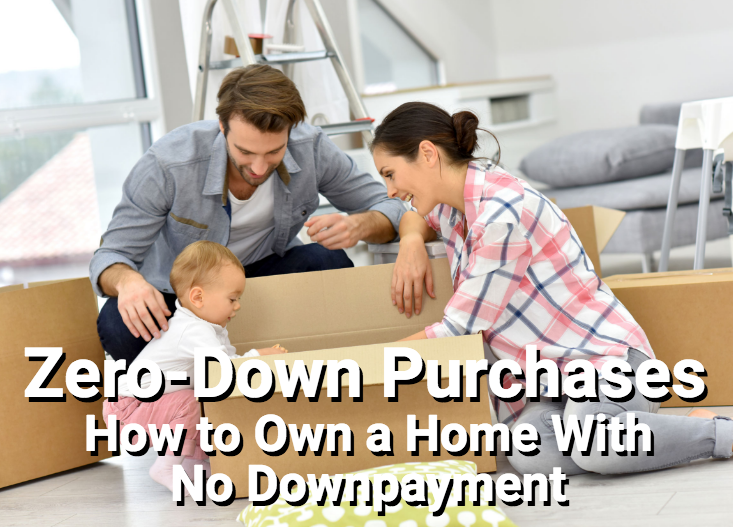You’re ready to quit paying rent checks and finally purchase a home, but your tight budget simply won’t allow you to save for a down payment. You’re not alone, as many people struggle with this issue, and it often causes them to stay out of the real estate market entirely.
However, you don’t have to let the dream of homeownership pass you by. By utilizing the right programs and the right strategies, you can obtain a home with zero-down purchases.
Options for Zero-Down Purchases
The Great Real Estate Myth: Down Payment is a Must
First of all, we should start by addressing the great myth of real estate: the required down payment. While down payments are always a good thing, as they allow you to purchase a home with less money borrowed (meaning less interest paid) and can often bring you lower interest rates, the down payment is not an absolute necessity. If you have it, then by all means use it, but if you don’t, it’s still possible to purchase a home.
And we’d like to show you how…
USDA Loans
The United States Department of Agriculture is typically associated with food quality and farming issues, but they are also involved in helping people purchase homes in rural areas. The USDA’s Rural Development program allows moderate to low-income earners to purchase a home in select rural communities, which doesn’t automatically mean a location in the country, as some suburban and small-town areas are also eligible.
This program also allows for 100% financing, which means you can acquire a zero-down mortgage loan. Also, there are no minimum credit requirements, but automated approval is available if you meet certain credit standards. Essentially, if you have a solid credit score and a decent history, the process will simply be faster; no or low credit scores will simply mean a longer process.
Although this is an excellent option, there are fewer people that qualify for these loans, and the areas where you can use the loans are limited. Also, there is a monthly insurance requirement, which will add to the total cost of the loan in the long term. However, with low upfront fees and the chance for zero-down on the loan, it remains a popular choice for buying a home in rural or suburban areas.
VA Loan
Although the name is a bit deceiving, a VA loan is actually made by the lender and guaranteed by the United States Department of Veteran’s Affairs. These loans, which are available to most veterans of the United States Armed Forces, as well as other non-military service branches, can be obtained with 0% down, although there are certain requirements, including a completed certificate of eligibility.
VA loans are possible with no down payment, but there will be upfront fees, although some borrowers may be exempt from these payments. For people who are not eligible for waiving the fees, the cost can often be added to the loan balance, which can essentially result in zero-down and zero-fees to obtain the loan. The VA does not require a credit score, although some lenders may have their own credit requirements in order to process the loan.

Down Payment Assistance Programs
If you (or the home you wish to purchase) is ineligible for either the USDA or VA loan programs, you can look towards downpayment assistance programs that are funded by taxpayers, private donors, and non-profit organizations.
For example, you could look towards housing finance agencies, which are funded by state governments and help people purchase a home by providing downpayment assistance. These programs have created a wide variety of community projects, such as the Mortgage Credit Certificates.
There are also community development block grants, which are funded by the Department of Housing and Urban Development. These grants seek to improve communities by promoting homeownership, which is seen as an important marker for an area’s general quality-of-life standards. One of the ways these programs prop up homeownership is through downpayment assistance.
One of the many non-profit organizations that assists with downpayments is the National Homebuyers Fund. This program dates back to 2002 and has provided well over $300 million in downpayment assistance. This program provides grants, meaning you won’t have to pay back the assistance after your home purchase. Regardless of how long you stay in the home, this non-profit essentially provides a gift, not a loan.
Gift Funds
Although this is technically not a zero-down purchase option, it is possible to use gift funds as your down payment. Yes, you’ll be making a downpayment, but the money can come from a generous friend or family member, eliminating the barrier of saving for a down payment.
For example, the FHA has a program where you only need a 3.5% downpayment to qualify for a mortgage loan, which is much lower than the often-stated 10% or 20% down. While 3.5% is can be a significant sum, it is a smaller amount; perhaps you could find a relative or friend who might gift this amount. It’s important to note that this will need to be a gift and not a personal loan, and you’ll likely have to produce documentation that the amount does not need to be repaid.
Community Seconds
Fannie Mae also has a program called Community Seconds, which allows you to receive additional funding to cover the down payment and closing costs. With this program, the additional funding can come from a non-profit, an employer, an affordable-housing program, or a municipality. This program can even be used to borrow over the value of the home, giving you money to make appropriate repairs, reconstruction, and remodeling.
Downpayment of Not, We Are Here to Help
The team at San Diego Purchase Loans is here to help you get an affordable loan that fits your budget. Contact us today and we’ll do what we can to increase your chances of mortgage-loan approval.
Put a team that believes in common-sense underwriting to work for you!


